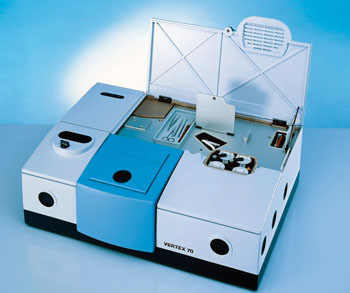Novel Blood Test Developed for Alzheimer's Diagnosis
By LabMedica International staff writers
Posted on 30 Mar 2016
A blood test has been developed that may potentially facilitate detection of Alzheimer's disease at an early stage and it is based on an immuno-chemical analysis using an infrared sensor. Posted on 30 Mar 2016
A major problem of Alzheimer's disease (AD) diagnosis is the fact that, by the time the first clinical symptoms appear, massive irreversible damage to the brain has already occurred and at that point, symptomatic treatment is the only available option.

Image: The Vertex 70v Fourier-transform infrared (FTIR) spectrometer (Photo courtesy of Bruker Optics GmbH).
Scientists at the Ruhr-University Bochum (Germany) and their colleagues analyzed the secondary structure of Amyloid-beta (Aβ) peptide in cerebrospinal fluid (CSF) and blood plasma of 141 patients which was measured with an immuno-infrared-sensor. The sensor's surface is coated with highly specific antibodies which extract biomarkers for Alzheimer's from the blood or the CSF, taken from the lower part of the back. The infrared sensor analyses of the biomarkers showed pathological changes, which can take place more than 15 years before any clinical symptoms appear. A Vertex 70v Fourier-transform infrared (FTIR) spectrometer (Bruker Optics GmbH; Ettlingen, Germany), equipped with a liquid nitrogen cooled mercury cadmium telluride (MCT) detector and water cooled, high efficiency mid- infrared (MIR) source was used.
The team achieved a diagnostic precision of 84% in the blood and 90% in cerebrospinal fluid, compared with the clinical gold standard. The test revealed an increase of misfolded biomarkers as spectral shift of Amyloid beta band below threshold, thus diagnosing AD. The results suggest that even in pre-dementia stages, an increased concentration of misfolded Amyloid beta peptides can be detected in body fluids. Additionally, a preliminary proof-of-concept study indicated an amide I band shift below the marker band already in patients with mild cognitive impairment due to AD. The presented immuno-IR-sensor method represents a promising, simple, robust, and label-free diagnostic tool for CSF and blood analysis.
Klaus Gerwert, PhD, a professor of Biophysics and a senior author of study, said, “We do not merely select one single possible folding arrangement of the peptide; rather, we detect how all existing Amyloid beta secondary structures are distributed, in their healthy and in their pathological forms. Tests that analyze Amyloid beta peptide are already available with so-called enzyme-linked immunosorbent assays (ELISA). They identify the total concentration, percentage of forms of different length, as well as the concentration of individual conformations in body fluids; but they have not, as yet, provided information on the diagnostically relevant distribution of the secondary structures at once.” The study was published on February 1, 2016, in the journal Analytical Chemistry.
Related Links:
Ruhr-University Bochum
Bruker Optics GmbH













